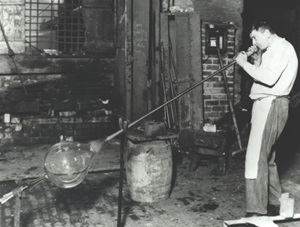Crown process
The first transparent window glass was formed on a blow pipe.
A gob of glass was blown into a sphere, which was cut at the end to create an opening. The sphere was then reheated to keep the glass softened, and spun so that the sphere would stretch out and flatten to make a crown or disc. This would create a slightly distorted but clear pane of glass. The distortion was mostly because the middle of the pane was thicker than the edges which had been stretched out.
 The finished product from this process was circular. Windows, however, are usually square and making square panels out of a disc of glass led to considerable wastage.
The finished product from this process was circular. Windows, however, are usually square and making square panels out of a disc of glass led to considerable wastage.
This method also resulted in a bullion being formed in the centre of the disc where the pipe had been attached. Although these bullions created a warped, distorted view they are still created to satisfy a fashion in domestic glazing. Examples of these bullions can still be see in pub windows.
When the Pilkington company first started production, it was named ‘St. Helens Crown Glass Company’ after this process which it used to produce glass.
Information sourced from The Glassmakers by T. C. Barker and Float: Pilkingtons' Glass Revolution by D. J. Bricknell and in-house.